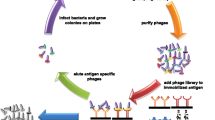Abstract
To isolate key sequences of transforming growth factor-beta 1 (TGF-β1) from the phage display 12-mer peptide library, synthesize the bioactive peptides, and evaluate their biological effects on fibroblasts. Using monoclonal anti-human TGF-β1 antibody as the target, a phage display 12-mer peptide library was screened to isolate target sequences. The key sequences of TGF-β1 were chosen through alignment analysis. Based on these sequences, bioactive peptides were produced. After being purified, structurally modified and fluorescence labeled, the peptides were added to the cultured fibroblasts. The effects of the biosynthesized peptides on fibroblasts were evaluated. Ten specific sequences similar to that of TGF-β1 were isolated from a phage display 12-mer peptide library. Seven key sequences were chosen to generate bioactive peptides of TGF-β1. Only one model peptide could bind to fibroblast and promote its proliferation. The result of quantitative real-time PCR analysis and Western blot analysis indicated the model peptide could promote both the mRNA expression and protein expression of TGF-β RII in fibroblasts. The key sequences of TGF-β1 can be screened from a phage display 12-mer peptide library. One of the bioactive peptides generated from the sequences can bind to and play biological effect on fibroblasts. The results are expected to help promoting wound healing.





Similar content being viewed by others
Change history
14 August 2020
A Correction to this paper has been published: https://doi.org/10.1007/s10989-020-10107-6
References
Ahmadvand D, Rasaee MJ, Rahbarizadeh F, Mohammadi M (2008) Production and characterization of a high-affinity nanobody against human endoglin. Hybridoma 27:353–360
Behrendt R, White P, Offer J (2016) Advances in Fmoc solid-phase peptide synthesis. J Pept Sci 22:4–27
Cho JW, Kang MC, Lee KS (2010) TGF-β1-treated ADSCs-CM promotes expression of type I collagen and MMP-1, migration of human skin fibroblasts, and wound healing in vitro and in vivo. Int J Mol Med 26:901–906
Chu Y, Guo F, Li Y, Li X, Zhou T, Guo Y (2008) A novel truncated TGF-β receptor II downregulates collagen synthesis and TGF-β I secretion of keloid fibroblasts. Connect Tissue Res 49:92–98
Demidova-Rice TN, Hamblin MR, Herman IM (2012) Acute and impaired wound healing: pathophysiology and current methods for drug delivery, part 2: role of growth factors in normal and pathological wound healing: therapeutic potential and methods of delivery. Adv Skin Wound Care 25:349–370
Gutiérrez J, Droppelmann CA, Contreras O, Takahashi C, Brandan E (2015) RECK-mediated β1-integrin regulation by TGF-β1 is critical for wound contraction in mice. PLoS ONE 10:e0135005
Jeon JK, Park SK, Lee JH (2015) Effects of high voltage pulsed current stimulation with a visible contraction intensity on expression of TGF-β1 and synthesis of type I collagen in wound-induced white rats. J Phys Ther Sci 27:1485–1490
Klass BR, Rolfe KJ, Grobbelaar AO (2009a) In vitro flexor tendon cell response to TGF-β1: a gene expression study. J Hand Surg Am 34:495–503
Klass BR, Grobbelaar AO, Rolfe KJ (2009b) Transforming growth factor β1 signalling, wound healing and repair: a multifunctional cytokine with clinical implications for wound repair, a delicate balance. Postgrad Med J 85:9–14
Lemes AC, Sala L, da Costa Ores J, Braga AR, Egea MB, Fernandes KF (2016) A review of the latest advances in encrypted bioactive peptides from protein-rich waste. Int J Mol Sci 17:e950
McVay CS, Velásquez M, Fralick JA (2007) Phage therapy of Pseudomonas aeruginosa infection in a mouse burn wound model. Antimicrob Agents Chemother 51:1934–1938
Mirastschijski U, Schnabel R, Claes J, Schneider W, Agren MS, Haaksma C, Tomasek JJ (2010) Matrix metalloproteinase inhibition delays wound healing and blocks the latent transforming growth factor-beta1-promoted myofibroblast formation and function. Wound Repair Regen 18:223–234
Okizaki S, Ito Y, Hosono K, Oba K, Ohkubo H, Amano H, Shichiri M, Majima M (2015) Suppressed recruitment of alternatively activated macrophages reduces TGF-β1 and impairs wound healing in streptozotocin-induced diabetic mice. Biomed Pharmacother 70:317–325
Pereira RF, Barrias CC, Granja PL, Bartolo PJ (2013) Advanced biofabrication strategies for skin regeneration and repair. Nanomedicine 8:603–621
Sadick H, Herberger A, Riedel K, Bran G, Goessler U, Hoermann K, Riedel F (2008) TGF-β1 antisense therapy modulates expression of matrix metalloproteinases in keloid-derived fibroblasts. Int J Mol Med 22:55–60
Sun L, Zheng C, Webster TJ (2016) Self-assembled peptide nanomaterials for biomedical applications: promises and pitfalls. Int J Nanomed 12:73–86
Takeo M, Lee W, Ito M (2015) Wound healing and skin regeneration. Cold Spring Harb Perspect Med 5:a023267
Wills QF, Kerrigan C, Soothill JS (2005) Experimental bacteriophage protection against Staphylococcus aureus abscesses in a rabbit model. Antimicrob Agents Chemother 49:1220–1221
Wrana JL, Attisano L, Wieser R, Ventura F, Massagué J (1994) Mechanism of activation of the TGF-beta receptor. Nature 370:341–347
Acknowledgements
This study was supported by the National Natural Science Foundation of China (30670571, 81201467), and the Scientific Research Fund for Youth of Chinese Academy of Medical Sciences and Peking Union Medical College (2017310007).
Author information
Authors and Affiliations
Corresponding authors
Ethics declarations
Conflict of interest
All the authors declare that they have no financial or personal interference with other people or organizations that could inappropriately influence their work.
Rights and permissions
About this article
Cite this article
Zong, X., Yu, P., Lu, H. et al. Phage Display, Peptide Production and Biological Assessment of Key Sequence of TGF-β1. Int J Pept Res Ther 25, 1217–1223 (2019). https://doi.org/10.1007/s10989-018-9774-x
Accepted:
Published:
Issue Date:
DOI: https://doi.org/10.1007/s10989-018-9774-x




